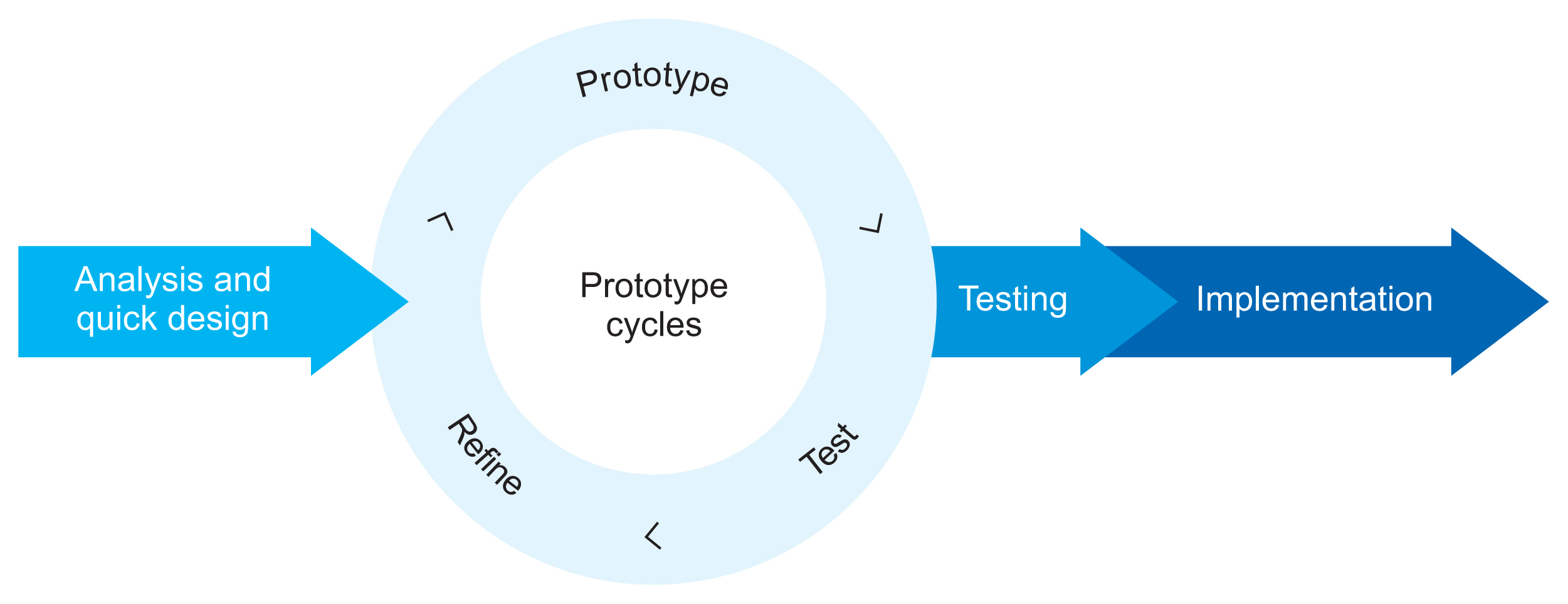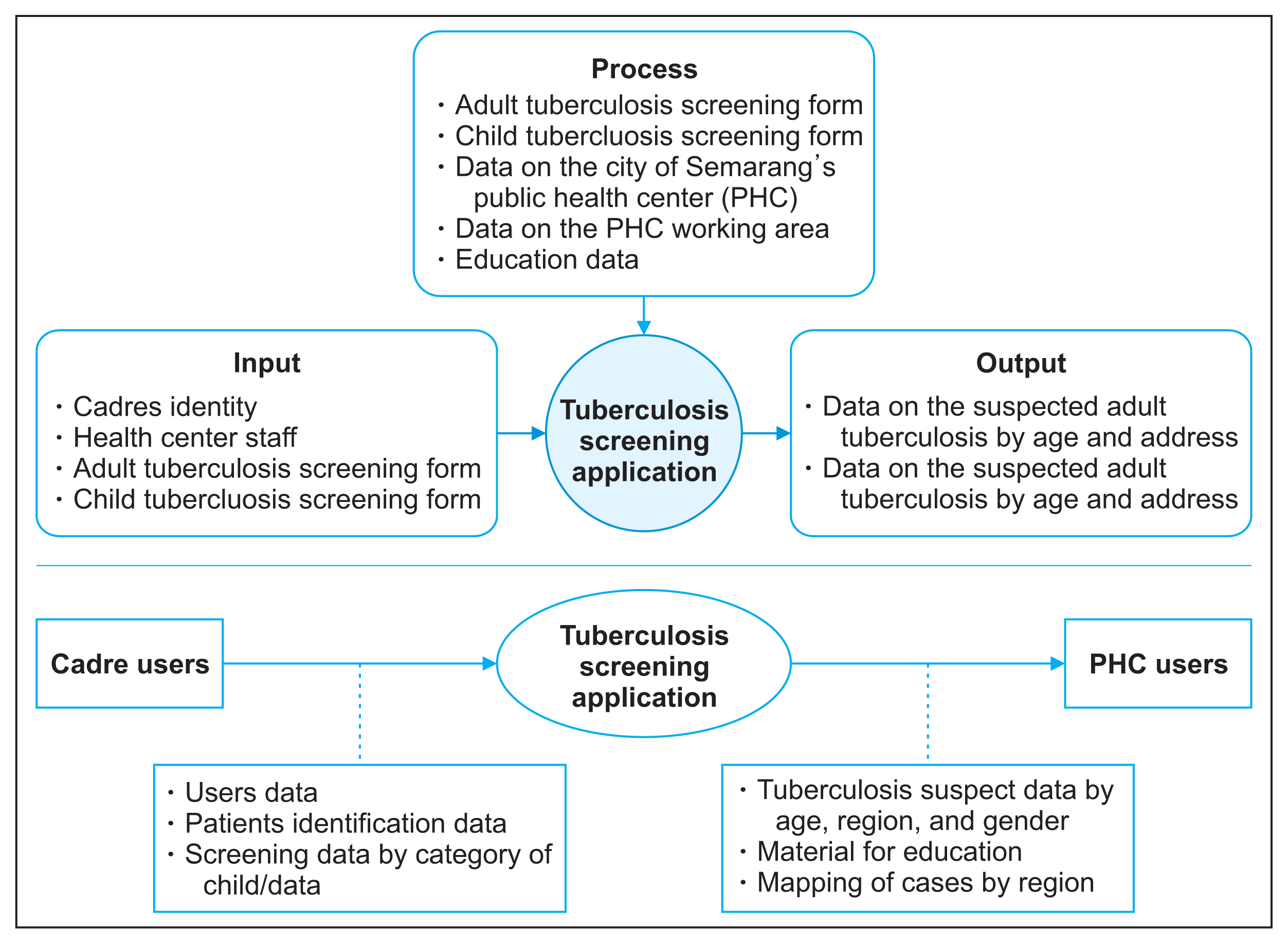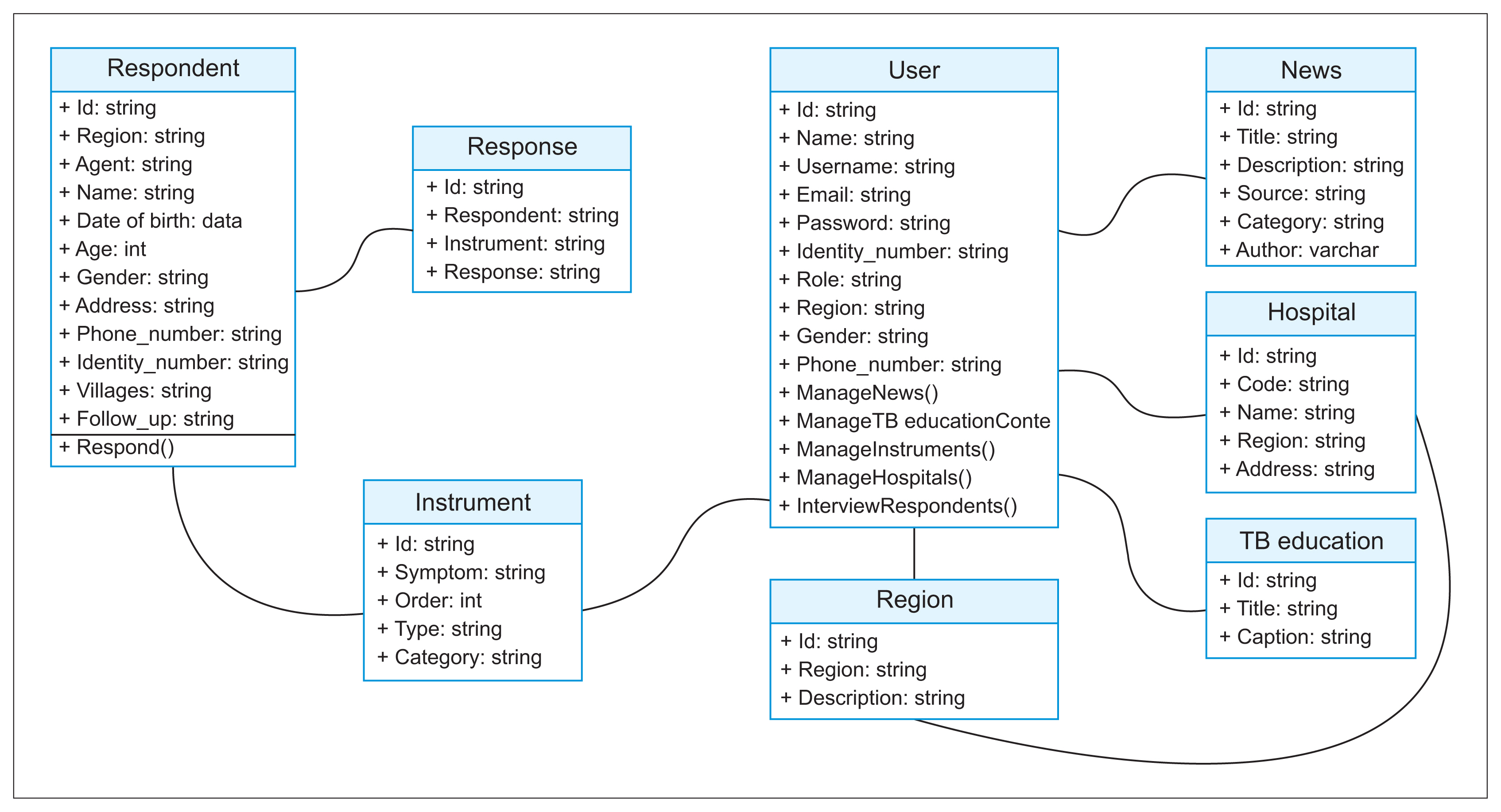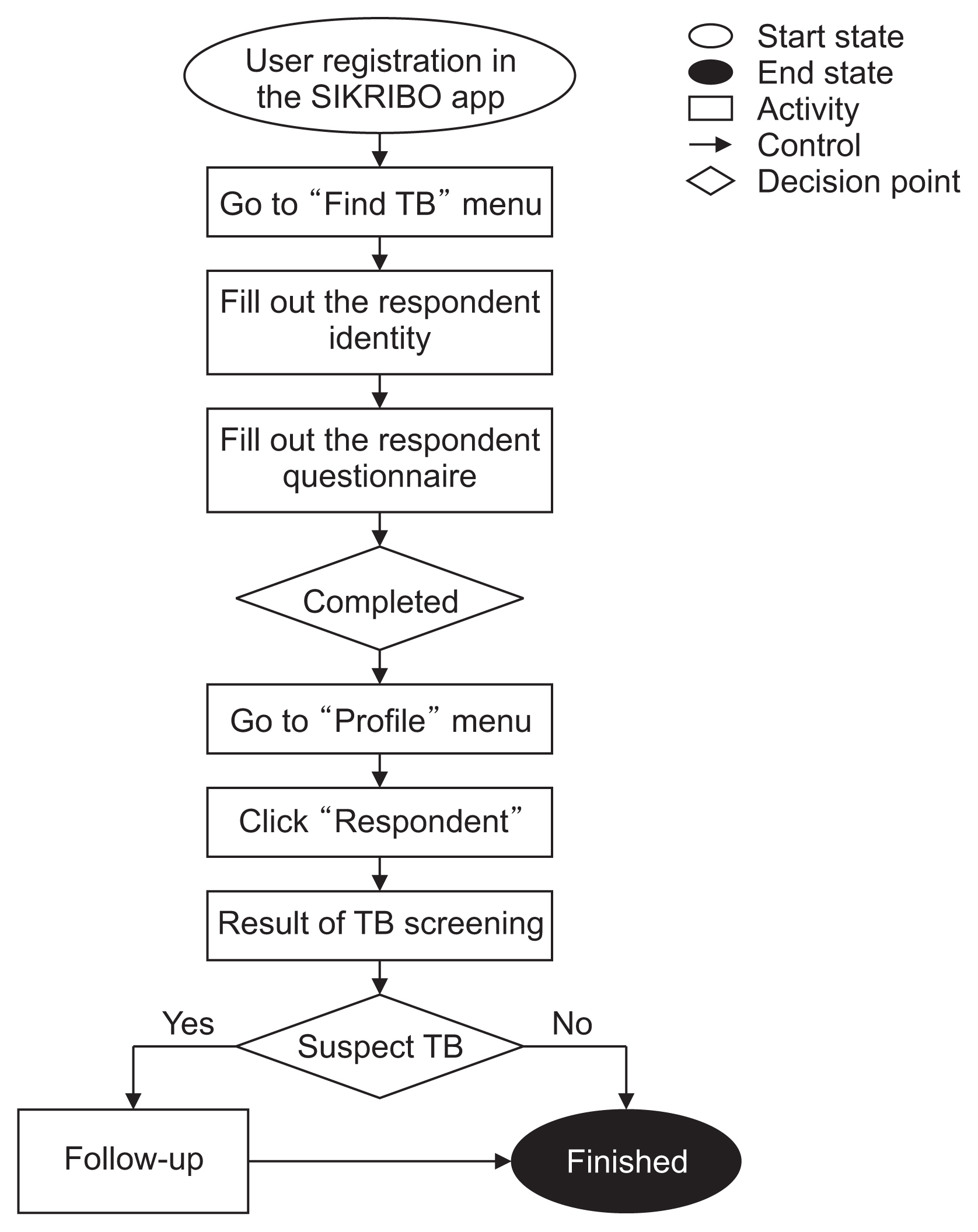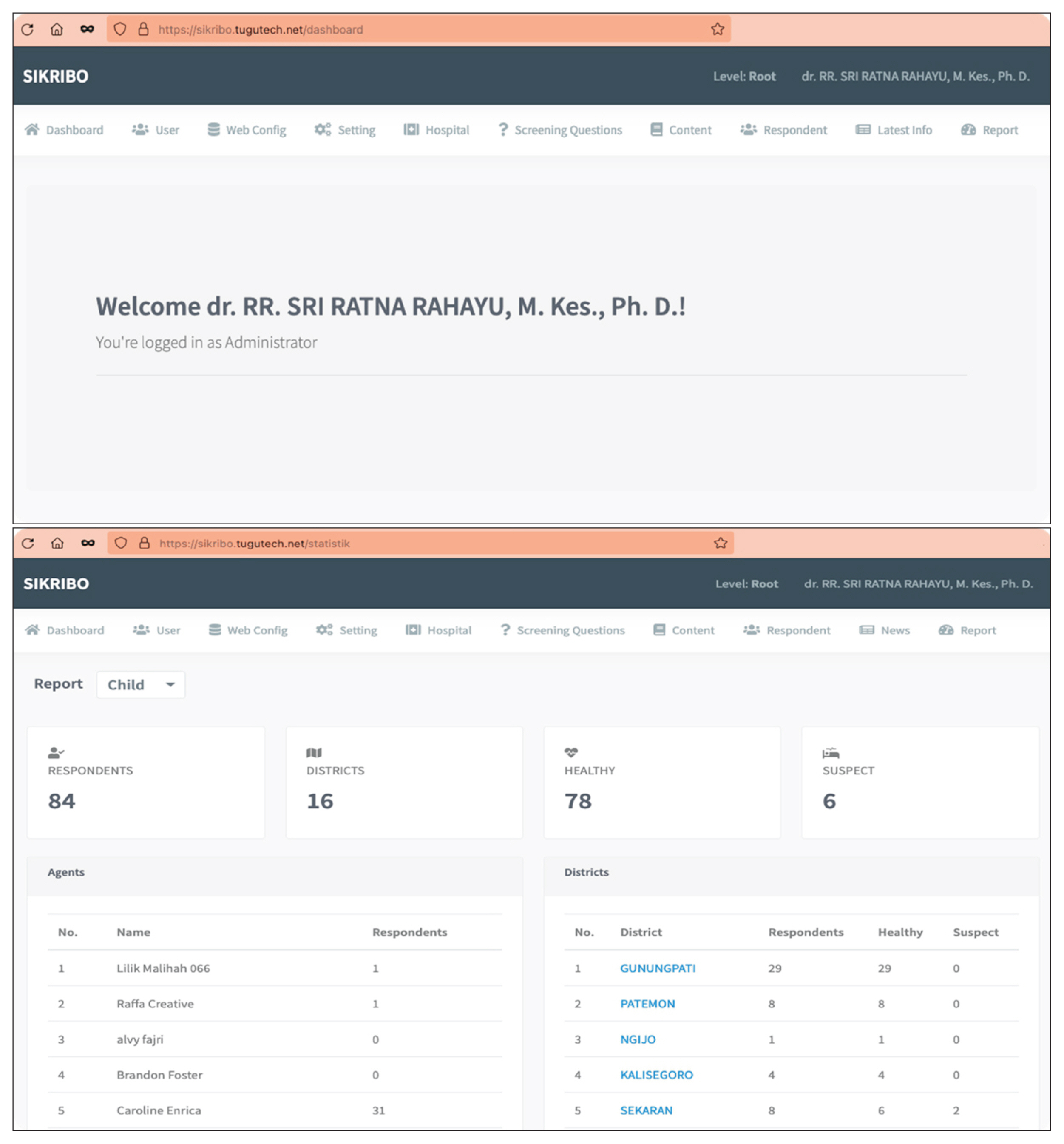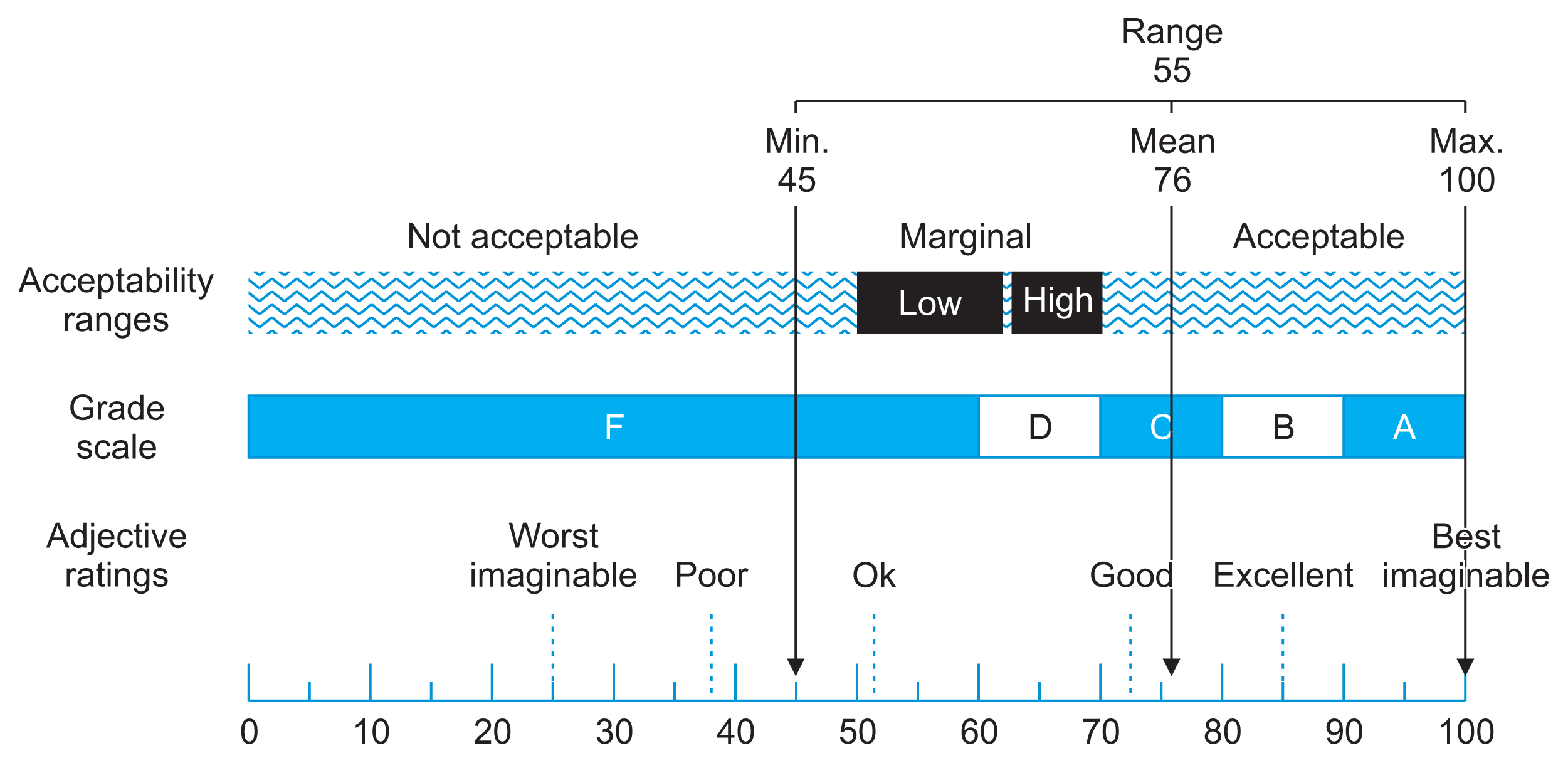Development of the SIKRIBO Mobile Health Application for Active Tuberculosis Case Detection in Semarang, Indonesia
Article information
Abstract
Objectives
This study was conducted to document the development and usability testing of SIKRIBO, a tuberculosis screening application.
Methods
The SIKRIBO application was developed using design science research methodology, which has six steps: problem identification and motivation, definition of objectives for a solution, product design and development, demonstration, evaluation, and communication. A system usability scale (SUS) questionnaire was used to assess application usability. A total of 20 health cadres (trained community members) and health workers participated in the usability tests.
Results
Two versions of the application were developed: Android-based for users and web-based for administrators. The Android-based version has four main menus: Find Tuberculosis, Tuberculosis Education, Latest Info, and Profile. The web version is accessible to health workers, as well as the research team and application developers who monitor and manage the user-conducted screenings. The average SUS score was 76 (standard deviation, 8.00).
Conclusions
This application was developed to help detect active tuberculosis cases in the community. The SUS results indicate that the application is highly usable. Thus, SIKRIBO is expected to be broadly implemented to increase tuberculosis case detection through active community participation.
I. Introduction
The World Health Organization reported that in 2019, 10 million people were infected with tuberculosis (TB) and 1.2 million died [1]. The transmission rate of smear-positive tuberculosis patients is 65%, and if a single person with active TB can infect 10 to 15 people, there would be 5.8 million infections within a year [2].
Indonesia has one of the highest TB case counts in the world, and the nation accounts for 10% of the global reporting gap of tuberculosis cases due to low case detection and reporting [1]. As highlighted in the national TB strategy, active case-finding is the primary focus of TB control. Poor TB case detection in a community may increase that community’s transmission rate [3].
Rahayu et al. [4] found that a lack of knowledge about TB symptoms and prevention contributes to delayed diagnosis. A separate longitudinal study indicated that only 52.5% of patients who began treatment were aware that cough was a symptom of TB. Those with undiagnosed TB act as reservoirs for transmission to their families [5].
The case notification rate (CNR) is an indicator of the scope of TB case detection. The Central Java TB CNR fell from 157 per 100,000 population in 2019 to 111 per 100,000 population in 2020 [6]. The TB CNR in Semarang (the capital city of Central Java Province) decreased from 258 per 100,000 population in 2019 to 155 per 100,000 population in 2020. In 2019 in Semarang, 1,653 TB cases were identified [7].
The Sekaran Public Health Center (PHC) identified 329 suspected TB cases in 2021 [7]. However prevalent the disease, community-based case-finding has not been conducted actively. One initiative of the Sekaran PHC involves the selection of individuals, termed health cadres, to empower the community in identifying TB cases. These community members can play a central role in family health and are trained for the early detection of TB symptoms in their family members, allowing for prompt and adequate treatment.
The coronavirus disease 2019 pandemic brought numerous challenges to tuberculosis treatment efforts, particularly in case detection. Direct contact had to be avoided, especially with individuals with cough symptoms [8]. However, direct physical contact can be replaced by virtual contact to diminish the risk of exposure. Mobile health (mHealth) applications are therefore a potential solution to the challenges in TB case-finding [9].
mHealth is the application of technology in medicine and public health through mobile devices. mHealth technologies include voice and short messaging services, mobile phone applications (or apps), remote monitoring, and portable sensors. This technology can also be equipped with geographic information and global positioning systems for geographic mapping [10].
mHealth has been recognized as an affordable innovation that can bring high-quality health services to patients in low- and middle-income countries. These countries include Indonesia, due to its poor health systems, high prevalence of tropical and infectious diseases, and high mortality [11]. However, Indonesia ranks fourth in the world in the use of mobile phones, with 61.7% of the population having access to a mobile device [12].
At least 55 mHealth applications related to TB treatment are available [13]. However, only 6% of the 55 mHealth apps focus on TB screening, which is underrepresented in the literature [9,13]. One example, TimBre, is an Indian-based TB app designed for cough screening for the detection of pulmonary tuberculosis. Another, Si Tubo, was made in Indonesia and facilitates the early detection of tuberculosis symptoms in children [13]. The objective of this study is to present comprehensive documentation of the development and usability testing of SIKRIBO, a tuberculosis screening application.
II. Methods
The SIKRIBO application was developed using design science research methodology. This approach provides a practical framework for developing, implementing, and evaluating the designed artifact with a focus on enhancing functional performance [14]. The six activities of this methodology are explained as follows and detailed in Figure 1.
1. Identifying Problems and Motivation
Preliminary field studies were conducted to identify the challenges associated with detecting TB cases.
2. Defining Objectives of a Solution
Literature reviews were conducted to build on prior research, map the issues, and determine a solution. Additionally, studies of the evaluation and testing of various TB apps were reviewed. The goal was to document the development and usability testing of Android-based applications for the detection of active TB cases.
3. Product Design and Development
The SIKRIBO app was created using rapid application development, which produces higher-quality results much faster than other software development methodologies [15] (Figure 2).
In the first stage (analysis and quick design), a data flow diagram was created to define how the application collects and delivers data (Figure 3). The application involves interactions between agents as users, the application as a tool, and the responses of the respondents; to accommodate these interactions smoothly, the application must be well-designed. A class diagram (Figure 4) was also created to define the properties and actions of each entity using the app.
This application was developed on the Android platform using Flutter, an open-source mobile application development framework. Android was chosen based on its 90.84% market share of Indonesian mobile phone users [15]. A backend web-based admin portal was developed using Laravel, one of the most popular PHP frameworks. After a cycle of prototyping, the application was subjected to three stages of user testing: internal trials, expert validity, and black-box testing (described in Section II-4). Finally, the app was deployed to a shared hosting environment and registered to a domain to allow public access.
4. Demonstration
This activity includes simulated running of the application via a prototype.
1) Internal trials
By analyzing the internal structure of a software program, white-box testing can uncover system implementation errors, such as poor key management. Path coverage testing was used to understand the cyclomatic complexity of the system.
2) Expert validity
Expert validity was attained through a trial of application products by media experts and public health professionals. A validation sheet questionnaire was distributed to assess and validate the application.
3) Black-box testing
Black-box testing involves observing only the fundamental aspects of the system to ensure that any specified system function or input is fully operational. In this stage, health workers of Sekaran PHC acted as administrators and users. The black-box test results showed that the application runs well and can be used reliably.
5. Evaluation (Usability Testing)
Usability testing is used to determine the extent to which a product allows users to achieve specific goals. The effectiveness, efficiency, and satisfaction of using a product are considered [16].
1) Research population and design
A cross-sectional design was used to evaluate the usability of the SIKRIBO app. The sample population included health cadres and health workers at Sekaran PHC in Semarang whose ages ranged from 17–65 years. The sample was designed to reflect the target users of SIKRIBO, who will be conducting TB screening for the public.
2) Sample size determination
Based on the findings of Nielsen [17], 20 respondents were chosen for the usability trials [18]. The sample was selected via convenience sampling, which is the most common method for usability studies [18]. Sampling was carried out at the Sekaran PHC in Semarang as a pilot health center.
3) Research instrument
The system usability scale (SUS) was chosen for the usability testing of the SIKRIBO app. This instrument is a well-validated measure of mobile application usability in questionnaire-based studies [19,20]. The SUS used in this study had been adapted into the Indonesian language, validated, and evaluated for reliability (Cronbach α = 0.841) [16]. Additionally, a kappa analysis of the SUS instrument was conducted to measure the agreement between two raters; this yielded a fairly high kappa value (κ = 0.494), indicating moderate agreement.
The SUS consisted of 10 statement items with favorable odd-numbered statements and unfavorable even-numbered statements. Responses were categorized as positive, neutral, or negative. Responses were considered positive if the respondent chose a score of 5 or 4 for odd items (favorable statements) or a score of 1 or 2 for even items (unfavorable statements), neutral if a score of 3 was selected, and negative if the respondent chose a score of 1 or 2 for odd items or a score of 5 or 4 for even items. Akmal Muhamat et al. [19], this system can counteract habitual bias in respondents.
For the favorable items, the individual item score was the scale position minus 1, and for the unfavorable items, the item score was 5 minus the scale position. The overall SUS score (ranging from 0 to 100) was obtained by adding the item scores and multiplying by 2.5. A product is considered to have good usability and high acceptance if the overall SUS score is 68 or higher [19].
4) Data collection
The participants were asked to install the SIKRIBO app on a smartphone by downloading it via the Google Play Store. They were told to utilize all functions of the application, including conducting TB screening independently and with other respondents. Participants were then asked to complete the SUS questionnaire.
5) Data analysis
The SUS results were calculated using Microsoft Excel (Microsoft Corporation, Redmond, WA, USA) and analyzed using SPSS Statistics version 26 (IBM Corp., Armonk, NY, USA) software.
6) Ethical considerations
This study was approved by the Health Research Ethics Commission of the Department of Public Health at Semarang State University (No. 096/KEPK/EC/2021). All participants provided informed consent.
6. Communication
The final stage is communication. After evaluation, the results of product development and product evaluation are communicated to experts, target subjects, and the public. In this study, the communication stage is carried out by documenting the results of research in the form of scientific publications in reputable international journals. In addition, researchers conducted socialization of the SIKRIBO application to various primary health services in the city of Semarang and its surroundings.
III. Results
1. Product Design and Development
The tuberculosis screening application has two versions.
1) Client-based on Android
The Android version is used to collect patient screening data. It has four main menus, shown in Figure 5.
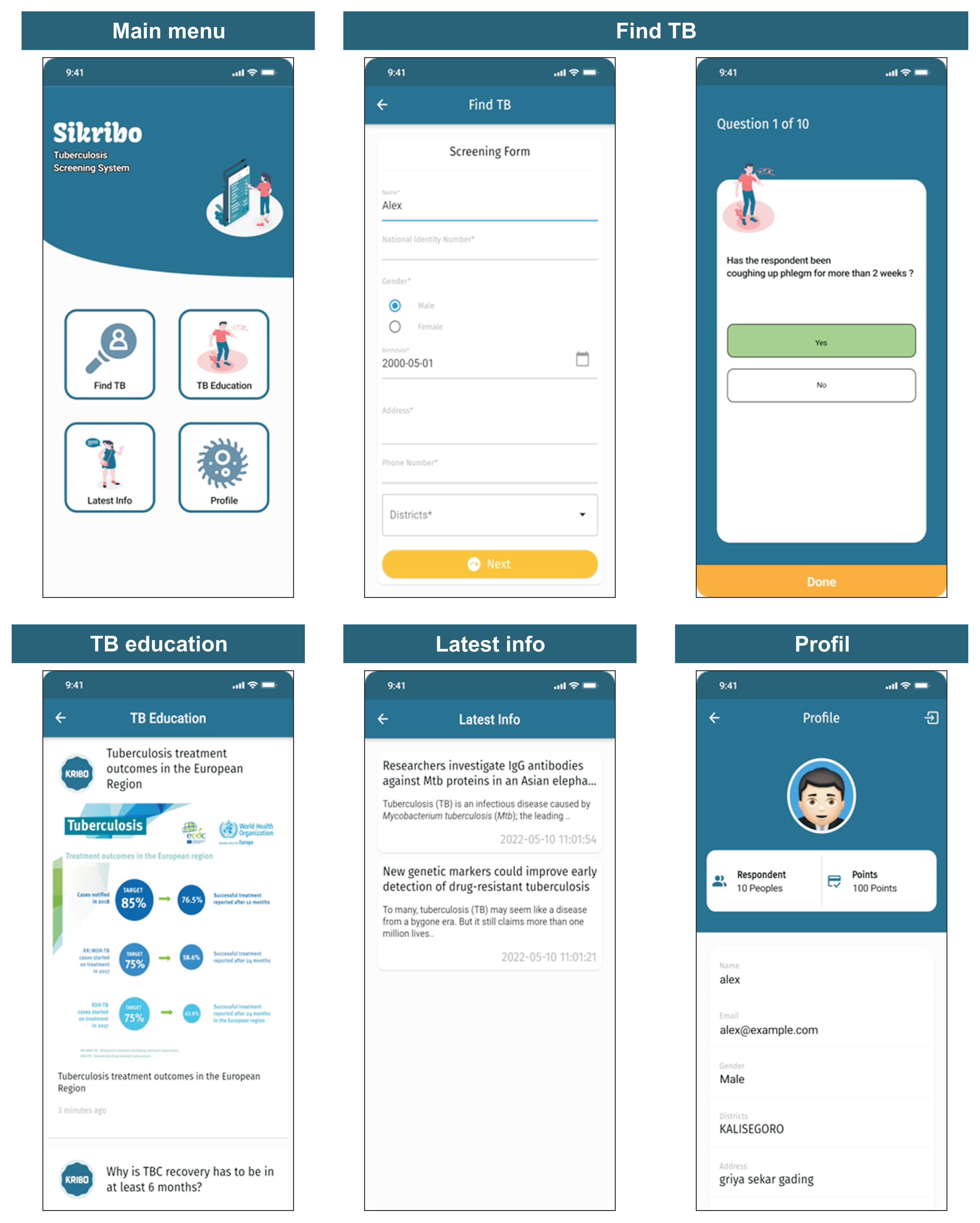
Display menus for the client-based Android application: Main Menu, Find TB, TB Education, Latest Info, and Profile. TB: tuberculosis.
(1) Find TB
This is a form that cadres must complete when performing early screening for TB in the community. The TB screening form contains 10 questions about TB symptoms based on the World Health Organization guidelines [21]. An individual with one of these symptoms is categorized as having suspected TB. This menu includes a personal data form for the person being screened. The screening results (healthy or suspect) can be seen in the Profile menu. Figure 6 shows the steps for TB screening with this application.
(2) TB Education
This menu contains TB-related information, intended to provide the community with knowledge about the disease.
(3) Latest Info
This menu displays the latest information about TB. The information was obtained from trusted sources that are expected to provide updated information about TB to combat the spread of TB-related hoaxes in the community.
(4) Profile
When a user logs in with a Google account, the profile menu automatically displays that user’s name and email address. The goal is to provide user data to PHCs to help maintain future communication regarding TB screening follow-up.
2. Evaluation (Usability Testing)
1) Sociodemographic characteristics
Usability testing included 20 participants with the demographic characteristics presented in Table 1. The most common age range for participants was 17–25 years old (40%). The highest education level of most respondents was the tertiary level (70%), and 90% of respondents were female.
2) Usability testing
Usability testing can be used to uncover and troubleshoot any unintended actions taken by users of mobile-based applications. As shown in Table 2, almost all statements had more positive than negative responses. Statements 1 and 7 had the highest percentage of positive responses (95%). Statement 10 had the highest percentage of negative responses, at 50%. The highest average score was for the third statement, about the user-friendliness of the application, at 3.4 (standard deviation [SD], 0.68), and the lowest average score was 1.7 (SD, 1.22) for statement 10, related to self-adjustment before app use. The SUS score was 76, which exceeds the system’s minimum usability score (68). The application thus has high acceptance and good usability. The usability score results are detailed in Figure 8.
IV. Discussion
Participants in the usability test displayed relatively high satisfaction with the SIKRIBO app. Most respondents indicated that they would use the application again, due to its ease of use. This finding is promising because user retention is a challenge in the development and implementation of mHealth [22]. According to Akmal Muhamat et al. [19], the ease of use of a mobile application is associated with the user’s intention to use it again. The respondents also agreed that the SIKRIBO application features run properly and are well integrated. In fact, almost all respondents agreed that most people would quickly learn how to use this application. This is possible because the SIKRIBO app was developed with easily understandable features common in mobile applications, with the goal of facilitating broad user-friendliness.
However, one-half of the respondents reported that a steep learning curve was required before using the application. This aligns with the findings of Pande et al. [23], in which as many as 50% of respondents provided a similar response. This is understandable given that new technology necessitates user adaptation. One challenge in implementing mHealth is taking the time to study the app before deploying it. Experts must be able to explain the benefits of the application to users before they are willing to adopt it into clinical practice [24].
The higher the SUS score, the more usable the system. In the present study, the mean SUS score was 76 (SD, 8.00), indicating good usability. Similarly, Idrus et al. [25] found an average SUS score of 77.7 for web-based human immunodeficiency virus and tuberculosis therapy management applications. In another study, the average mHealth SUS score was 80.5 (SD, 11.47), indicating good but not excellent usability [26].
The main purpose of the SIKRIBO app is to assist in early TB case detection in the community by utilizing digital technology. Screening through symptoms is an easy way to identify TB cases in the community. Moreover, involving the community in TB screening increases the rate of TB detection. The SIKRIBO app can help health facilities conduct TB screening in the community by involving the community as cadres. The results of these screenings are recorded in the web-based admin version of SIKRIBO to monitor cadres in screening and follow-up suspected TB cases for diagnostic examinations. Even the public can use SIKRIBO for self-screening.
mHealth can be used to help screen for infectious diseases and strengthen infectious disease surveillance across the globe. In addition, it may increase the availability of scientific research and public health initiatives [27]. Even from the perspective of health workers, as reported by Faujdar et al. [28], such digital systems are making work easier and faster, although adaptation can be slow. The SIKRIBO app is not only a screening application, but also a medium for public education about TB and its prevention, provided in the TB Education feature. Mahmood et al. [29] underscored that smartphones increase the efficiency of health education on disease and its prevention. In line with these potentially great benefits in public health, the SIKRIBO application should be released in a large initial trial for utilization by primary health facilities.
Acknowledgments
The authors would like to thank all the participants and all experts who participated in this study. This work was supported by Postgraduate, Universitas Negeri Semarang and Research Institute and Community Service, Universitas Negeri Semarang.
Notes
Conflict of Interest
No potential conflict of interest relevant to this article was reported.


